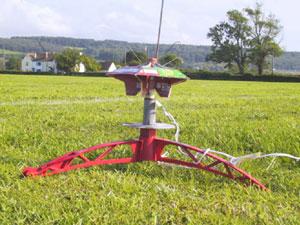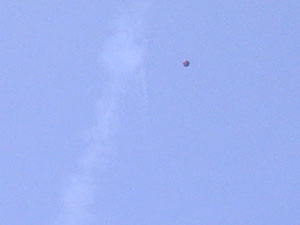| Construction Rating: | starstarstarstarstar_border |
| Flight Rating: | starstarstarstarstar |
| Overall Rating: | starstarstarstarstar |
| Length: | 3.20 inches |
| Manufacturer: | FlisKits  |
| Skill Level: | 2 |
| Style: | Saucer |
CONSTRUCTION:
Being newish to this hobby, I'm slowly working my way through the different
types of rocket there are to offer. My first cluster was Fliskits' superb
Deuce's Wild; having had a lot of fun building and flying that one, I looked to
Fliskits' Pheord X150 for my first saucer type. As Fliskits don't yet have a
vendor in the UK, I have to buy direct from Fliskits - they are great to deal
with, and are very prompt in sending out goods. It only takes about 5-6 days
for me to get my goodies! All goods are well packaged for transport; my Pheord
package had a bashed corner, but the kit inside was unharmed.
The package also contained a handful of Fliskits catalogues, and a personal letter from Jim - nice touch. Like other Fliskit kits, my Pheord came in a very attractive display bag. Eye catching design, individually numbered (mine is #16), and the contents visible through the back. Everything was present and correct, and of the usual best quality associated with Fliskits products.
The kit is essentially a 18mm body tube, surrounded by five fins, covered with a card shroud. There are also five steel 'antenna', which are used as shock absorbers for the airbrake landing. Special note must be made of the quality of the balsa supplied with this kit (and all Fliskits kits, it seems). Having only used Estes quality balsa before discovering Fliskits, these kits are a dream to build balsa-wise. On my Deuce, I only did the minimum of sanding/sealing on the balsa parts, as having the grain of a quality balsa showing through the paint looks pretty cool to me.
The instructions are very concise, and very clear. At no point was I left thinking "what do they mean there?", unlike experiences I've had with supposedly easier models from 'other' manufacturers. Almost all steps have a well drawn diagram, and there are hints and tips for construction, throughout the documentation.
Construction starts with the fins. The fin patterns double up as decals on the final model. First the left side ones. These are stuck onto the balsa, the fins are cut, and then the right side decals are attached. The decals are printed on that 'cracked' backed peel-and-stick paper, and this is where I have my first gripe about this model. In order to 'crack' the backing paper, you have to crease the decal, which spoils it. I got round this by using the blade of my hobby knife to 'pick' at the edges of the stickers, until I had enough backing paper free to get a grip .... a rather tedious task, I found.
Next, the bodytube decal is attached around the outside of the central tube. This was about 1mm short, and left a small amount of bodytube showing. This was later covered by a fin, so is mostly unnoticeable. In mentioned this in a short review I posted on the Rocketry Forum, and received an almost immediate reply from Jim who says he’s looking into it immediately - theres a good example of the high level of customer service to be expected from Fliskits.
Attaching the fins is next. To help this a handy fin guide is included, which requires a spent engine to be glued in the middle, to take the central bodytube. The fins are then attached by lining them up to the lines on the guide. Owning a Deuce, I have PLENTY of spent engines. After the fins have been left to dry, the shroud is cut out from best quality card; 'structural' folds made, and then glued to the top edges of the fins. The fin guide ensured that the shroud fitted precisely.
There is a lot of cutting involved in this model; to help I invested in a small (200x100mm) self-healing cutting mat, which came with a hobby knife. This cost less than a fiver, from my local stationary shop. I'd consider a piece of kit, like this, to be essential in building a model with this much cutting involved; and is a very handy item to have for general template cutting etc.
Now onto the 'antenna'. These are made of five 150x1mm lengths of steel wire, which require bending into shape, with a pair of long nosed pliers. The steel used is VERY strong (again, reflecting the high standards of Fliskits component quality), and was a bit of a devil to bend. This said, I managed to bend one joint the wrong way, and in trying to correct this snapped the wire (DOH!). I calculated that this 'antenna', could be bodged onto the model, and carried on with a broken 'antenna'. The 'antenna' are then attached along the sides of the fins, and a launch lug attached. The snapped 'antenna' came in handy here, as it meant there was a side of a fin with no wire, making gluing on of the launch lug easy.
The instructions then advise you to apply a thin film of glue along all the exposed edges, in order to seal them. After attaching the "Custom Red-Rag Anti-Matter Cap", the bird is ready to go, and looks great! There is a lot of detail, and humour, in the artwork; and is a good colour to show up in the sky.
Construction Rating: 4 out of 5 The decal backing paper, and the bodytube decal not fitting lost the 1/2 point. Rating should be 4.75 but 1/2 is the smallest I can deduct
FLIGHT/RECOVERY:
The Pheord is designed to fly on B6-0 and C6-0 engines. I used a B6-0 for the
first flight. Prepping is very easy; shove in an igniter, whack the engine into
the centre tube, tape it in and Bob's you're auntie's living lover! No messing
about with wadding or recovery devices. After taking a photo on the pad, the
Pheord was launched. It went straight up, leaving a lovely smoke trail (being a
calm evening, the smoke lingered for a while). At motor burnout, the bird arced
over, and fell to earth.
Descent was stable, straight, and graceful; the model landing on the 'antenna', bouncing once. A very quick, and fun, flight. I then launched it on a C6-0. This should be the only motor recommended for this bird. This engine really does the Pheord proud. You get a much higher flight, much better smoke trails, and a more satisfying 'whoosh' noise. The Pheord still landed only a few meters from the pad, so there’s no danger of loosing it - even on the smallest field. I then got my friend to launch it (on a C6-0), whilst I attempted to get some launch photos - again, another superb flight and recovery. I've included some photos of this flight.
Flight/Revovery Rating: 5 out of 5 - add a bonus point when flying on a C
OVERALL:
This is, typically for Fliskits, a VERY good kit overall. At only just over
£11 including shipping from the USA, this kit is exceptional value for
money. Estes kits cost more than that, over here, before you add delivery
costs! The kit looks very durable; having suffered no damage, or noticeable
wear, after three flights. I hope to have many more C powered flights with this
bird. The documentation (instructions and face card etc) is littered with
tongue-in-cheek jokes about red-necks. Some of the more subtle jokes are
probably lost on a Brit, like me, but I did find some of the jokes most
amusing. I especially liked the 'things NOT recommended for building OR
flying...' section. The face card also contained launching requirements for
another Fliskits product (the HUGE Richter Recker). I pointed this rather
embarrassing (and amusing) typo out to Jim on the Rocketry Forum, and he’s
going to correct this on the next print run of the face cards. The emphasis,
with this bird, is on fun, fun, fun; and it provides! Its challenging, but
uncomplicated, to build for an experienced beginner like myself. Easy to prep,
and great fun to fly.
Overall Rating: 5 out of 5 If you dont have one - get one! If enough people get one, Jim will be able to reprint the face card, and lose the embarrasing Richter Recker typo!
Other Reviews
- FlisKits Pheord X150 By Nick Esselman
The FlisKits Pheord X150 is more than rocketry, it's humor as well. Starting with its name, Pheord, pronounced like Ford, add the X150 and you'd think you were dealing with a pickup truck. And the similarity does not stop there. Notice FlisKit's introduction: " 'Built Pheord Tough' takes on a whole new meaning! The 2003 Pheord X150 come fully outfitted for the alien on the go, whether you are ...
 |
 |
Flights
Date | Flyer | Rocket | Altitude |
|---|---|---|---|
Sponsored Ads
 |
 |














